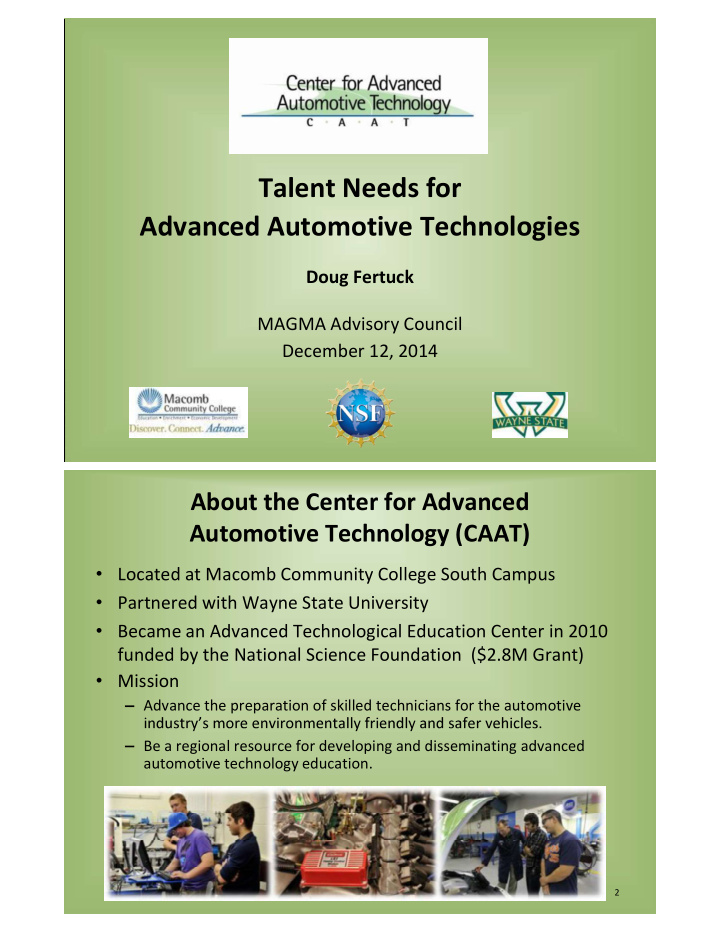



Talent Needs for Advanced Automotive Technologies Doug Fertuck MAGMA Advisory Council December 12, 2014 About the Center for Advanced Automotive Technology (CAAT) Located at Macomb Community College South Campus Partnered with Wayne State University Became an Advanced Technological Education Center in 2010 funded by the National Science Foundation ($2.8M Grant) Mission Advance the preparation of skilled technicians for the automotive Be a regional resource for developing and disseminating advanced automotive technology education. 2
Preparing automotive technicians and designers in community colleges for advanced technology jobs Increasing the flow of students through the pipeline to jobs Collaborating and sharing across educational institutions Partnering with industry to understand their needs 3
Strength and Value through Partnerships Received additional NSF funding of $2.0M through July 31, 2017 Mission remains preparing technicians and technologists to work on advanced automotive technology Technical scope: Continues to support vehicle electrification and other automotive propulsion technologies extends to include the materials lightweighting and automated and connected vehicles 6
CAAT Website - www.autocaat.org 7 Updated Industry Needs in Advanced Automotive technology
Drivers of the Auto Industry Future Source: Automotive Industry Office, Michigan Economic Development Corporation 9 WardsAuto Annual Survey of Industry Engineers on Fuel Economy Strategies Question: What technology is your company focused on to help the industry meet 2025 fuel economy standards (multiple answers permitted)? 49%, lightweighting 39%, engine efficiency 26%, vehicle electrification 11%, downsizing For the 2011 survey, engine efficiency was the area of largest focus. Source: 2014 WardsAuto, DuPont Automotive Trends Benchmark Study 10
Advanced Powertrain Technologies Are Being Widely Applied Plug-In Vehicles Accumulate on the Road
History of Vehicle Mass, Power, and Fuel Economy Trend of Historical Vehicle Size Increases (Europe) 14
Example of the Old vs New Fiat 500 15 Typical Vehicle Mass Break-Down by System (Land Rover)
How Does Mass Reduction Achieve Fuel Economy Savings? Less energy required to accelerate the vehicle (F=ma) Less rolling resistance at speed Lightweighting begets lightweighting: Smaller powertrains Lighter chassis and brake components Smaller gas tanks Smaller wheels and tires 17 Mass Reduction Approaches for Body Structures and Closures
Progression of Lightweighting Strategies by Cost Examples of Sustained Lightweight Material Applications Aluminum Castings Engine blocks and heads Transmissions Heat Exchangers Advanced High Strength Steels Aluminum Closure Panels
Multiple Materials In Body-In-White ATS Example: Mild Steel High Strength Low Alloy Advanced High Strength Steel Ultra High Strength Steel and Bake Hardened Steel 38% 10% 32% 10% 4% 6% Aluminum Press Hardened Steel Material Distribution as a Percent of BIW Mass Lightweighting Technologies
Assemblies of Advanced and Multiple Materials Complicate Joining Enabling Computer-aided Engineering (CAE) Can Limit Materials Choices
Typical Worker Skills Required in the Field of Lightweight Vehicles Designers Understanding of automotive materials properties for design including strength, stiffness, formability, joining methods, reparability, and recycling. Familiarity with proven, sustainable automotive material choices Understanding of systems engineering, CAE modeling , and manufacturing systems Technicians Knowledge of how and when to repair many different automotive materials Ability to assess and repair many different types of automotive joints and complex assemblies Familiarity with how to identify and sort materials for reprocessing 25 Ford Takes a Leap: the New 2015 All Aluminum F150 Pickup Body
Drivers of the Auto Industry Future Source: Automotive Industry Office, Michigan Economic Development Corporation 27 Connected & Automated Vehicles Defined Connected and automated vehicles use any of a number of different communication technologies to communicate with: The driver Each other Roadside infrastructure Satellites 28
Automated and Connected Vehicles 29
The Environment of the Connected Automated Vehicle
Integrated Systems Approach to Vehicle Automation
The Complexity of Automated Driving 37
Typical Technician Skills Required in the Field of Automated Vehicles Basic automotive and prototype shop knowledge (teardown vehicles, build harnesses, basic fabrication skills, troubleshoot auto systems without manuals) Electronics skills (ECMs, sensors and sensor fusion, antennas, CAN and cable protocols, displays, soldering, shielding, troubleshooting) Software Skills (embedded systems, basic programming, networks, security systems, user interfaces) Understanding of Communication protocols (Satellite, LTE/cellular, WiFi, DSRC, Bluetooth) Lab testing and data analysis 38 Stay Connected with the CAAT Visit our website at www.autocaat.org Sign up for our monthly newsletter Follow us on social media Plan to attend the FREE CAAT Conference on May 1, 2015 Work with us on your workforce development, curriculum development, and credentialing initiatives 39
Thank You! Questions?
Recommend
More recommend